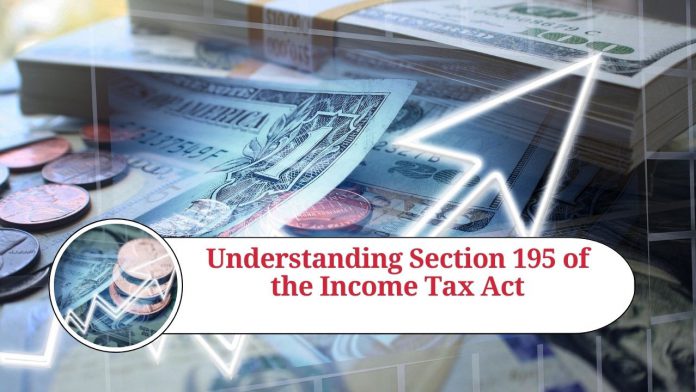Section 195 of the Income Tax Act, 1961 deals with the deduction of tax at source on payment made to non-residents. This section applies to all kinds of payments made to non-residents, such as salary, interest, royalty, commission, etc. The objective of this section is to ensure that the tax liability of non-residents is fulfilled in India.
Here are the key points that you need to know about Section 195:
- Who is a non-resident? A non-resident is a person who is not a resident in India as per the Income Tax Act. A resident is defined as a person who has been in India for at least 182 days in a financial year or a person who has been in India for at least 60 days in a financial year and for at least 365 days in the four preceding financial years.
- When is TDS required to be deducted under Section 195? TDS is required to be deducted at the time of payment or credit to the non-resident. The tax deducted needs to be remitted to the government within a specified time.
- Rate of TDS under Section 195: The rate of TDS under Section 195 varies depending on the nature of the payment made to the non-resident. For example, the TDS rate on interest paid to non-residents is 20%, while the TDS rate on royalty payment is 10%.
- Exemptions from TDS under Section 195: There are certain exemptions from TDS under Section 195. For instance, TDS is not required to be deducted on payments made to non-residents for the purchase of goods. Similarly, TDS is not required to be deducted on payments made to non-residents for the use of equipment or machinery.
- Compliance requirements under Section 195: The payer is required to obtain a Tax Residency Certificate (TRC) from the non-resident in order to claim the benefit of the Double Taxation Avoidance Agreement (DTAA) between India and the country of residence of the non-resident. The payer is also required to file Form 15CA and 15CB, which are forms used for furnishing information regarding payments to non-residents.
Here are some additional details about Section 195 of the Income Tax Act:
- Applicability of Section 195: Section 195 applies to all payments made to non-residents, whether or not the payment is chargeable to tax in India. It is the responsibility of the person making the payment to ensure that the tax is deducted at the appropriate rate.
- DTAA and Section 195: The Double Taxation Avoidance Agreement (DTAA) between India and the country of residence of the non-resident may provide for a lower rate of tax or exemption from tax on certain types of income. In such cases, the payer can obtain a Tax Residency Certificate (TRC) from the non-resident and claim the benefit of the DTAA. However, even if the DTAA provides for exemption from tax, TDS under Section 195 may still be required to be deducted.
- Procedure for TDS under Section 195: The person making the payment to the non-resident is required to deduct tax at source and remit the same to the government within the prescribed time limit. The TDS can be deposited using challan 281. The payer is also required to file a TDS return in Form 27Q within the due date.
- Consequences of non-compliance: Non-compliance with the provisions of Section 195 can result in penalties and interest. If the tax is not deducted at source or is deducted but not remitted to the government, the payer can be held liable for the tax as well as penalty and interest. The non-resident may also face difficulties in claiming credit for the tax deducted at source.
- Recent changes in Section 195: The Finance Act, 2020 has introduced certain changes in Section 195. Under the new provisions, non-residents are required to file Form 10F in order to claim the benefit of the DTAA. The provision also empowers the government to prescribe the manner and form of filing Form 10F.
In conclusion
Section 195 of the Income Tax Act is an important provision that governs the taxation of non-residents in India. It is important for payers to comply with the provisions of this section in order to avoid any penalties or legal issues. The recent changes in the provision have made it even more important for payers to stay updated with the latest developments in this regard.
Read more useful content:
- section 234e of income tax act
- section 286 of income tax act
- section 90a of income tax act
- section 40a(7) of income tax act
- section 226(3) of income tax act
- section 24 of income tax act
Frequently Asked Questions (FAQs)
Q1. What is Section 195 of the Income Tax Act?
A1. Section 195 deals with the deduction of tax at source on payments made to non-residents.
Q2. Who is a non-resident?
A2. A non-resident is a person who is not a resident in India as per the Income Tax Act.
Q3. When is TDS required to be deducted under Section 195?
A3. TDS is required to be deducted at the time of payment or credit to the non-resident.
Q4. What is the rate of TDS under Section 195?
A4. The rate of TDS under Section 195 varies depending on the nature of the payment made to the non-resident.
Q5. Are there any exemptions from TDS under Section 195?
A5. Yes, there are certain exemptions from TDS under Section 195. For example, TDS is not required to be deducted on payments made to non-residents for the purchase of goods.
Q6. What are the compliance requirements under Section 195?
A6. The payer is required to obtain a Tax Residency Certificate (TRC) from the non-resident in order to claim the benefit of the Double Taxation Avoidance Agreement (DTAA) between India and the country of residence of the non-resident. The payer is also required to file Form 15CA and 15CB, which are forms used for furnishing information regarding payments to non-residents.
Q7. What are the consequences of non-compliance with Section 195?
A7. Non-compliance with the provisions of Section 195 can result in penalties and interest.
Q8. Can non-residents claim a refund of TDS?
A8. Yes, non-residents can claim a refund of TDS if the tax deducted is in excess of their actual tax liability.
Q9. How can a payer determine the correct rate of TDS under Section 195?
A9. The correct rate of TDS under Section 195 can be determined by referring to the relevant provisions of the Income Tax Act and the DTAA between India and the country of residence of the non-resident.
Q10. What are the recent changes in Section 195?
A10. The Finance Act, 2020 has introduced certain changes in Section 195, including the requirement for non-residents to file Form 10F in order to claim the benefit of the DTAA.




















